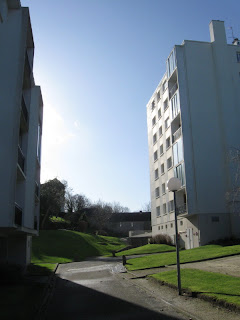 (It's about time I got some more photos on our blog. I have others, but they'll have to wait for a later date. I hope to get this up to date within a week, so there will be more after the ones I'm posting today.)
(It's about time I got some more photos on our blog. I have others, but they'll have to wait for a later date. I hope to get this up to date within a week, so there will be more after the ones I'm posting today.)Early morning view of our apartment area. Our building is on the right, and our place is the two far windows on the third floor. We have grass and some flowers year-round, and a balcony that faces south. A lot of our neighbors are retired, and some of the others are professionals. It's most of the time quite peaceful, and we're only about 15 minutes walk from the church and the center of downtown.



















